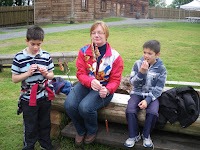 Saturday, we took a trip out to Fort Langley. It is a National Historic Site and where the Hudson's Bay Company built a supply fort in the early 1800s near the mouth of the Fraser River. It also plays a major role in BC's history, as in 1858 the province of British Columbia was proclaimed here by the first governor, James Douglas. The fort has been restored quite a bit since the last time we visited here in 2009.
Saturday, we took a trip out to Fort Langley. It is a National Historic Site and where the Hudson's Bay Company built a supply fort in the early 1800s near the mouth of the Fraser River. It also plays a major role in BC's history, as in 1858 the province of British Columbia was proclaimed here by the first governor, James Douglas. The fort has been restored quite a bit since the last time we visited here in 2009.Fort Langley was not a fighting fort, but was a supply and distribution fort. Because it was not a fighting fort, it did not have the big cannons and defences like moats. It was where the natives would come and trade furs for goods, and also where furs from other forts in the interior would arrive and be packaged for shipment to England. It was a very long trip back to England because they had to sail around the bottom of South America. This was well before they built the Panama Canal.
This was the blacksmith shop. They do all the work with metals to build things for the fort and for trade. "Smith" comes from the word "smite" which means "to hit." They demonstrated how to make a hook, which would be used for hanging tools on. They also traded hooks with the natives, who used it to hang salmon to dry. There was a forge with a big bellows pump for pushing air in to feed the fire. In many blacksmith shops, boys as young as six or seven would often have a job keeping the fires going and making nails.
Here we are baking bannock over a fire. Bannock came from Scotland, and is a doughy mix of flour, water, baking powder, salt, maybe butter and sugar, and anything else they can put in like berries. It takes a while to heat over the fire without getting it all burnt. Meanwhile, the smoke gets in our eyes and we have to shut them while baking the bannock.
The bannock was quite good! Here's a recipe we found on the internet: http://allrecipes.com/Recipe/bannock/Detail.aspx
In 1859, British Columbia went gold crazy, when people discovered gold in the interior in places like Barkerville. This made the fort even more important, because all the miners bought supplies here before going up the Fraser River into the interior. The blacksmith became VERY busy making pickaxes and shovels!
At the storehouse, we saw samples of all the different types of furs that would be traded. These included coyotes, beaver, fox, mink, martin, sea otter, fischer, wolverine, badger, raccoon, bear. To prepare the skins before trading, the skins had to be cleaned of all flesh and fat, because even a little bit can rot the skin and the entire bale of fur during shipment. In many forts, beavers and other skins were used as money instead of coins or paper money. The skins are pressed into a dense bale of nearly 100 pounds, and the voyageurs sometimes carried two of them at a time!
This was a ceremonial canoe that was donated to the people of British Columbia and housed at Fort Langley.
 |
| This bunny matches the camouflage of my sweater perfectly! |
 |
| Here we are feeding the baby goats, called "kids," at the fort. They also had pigs, sheep, bunnies, and chickens. |
 |
| Family mugshot, Part 1: Mama goat and her two babies. |
 |
| Family mugshot, Part 2: Mommy and us with her uncle Guy and her cousin Matthew. We went out to visit Guy for dinner after Fort Langley. |







No comments:
Post a Comment